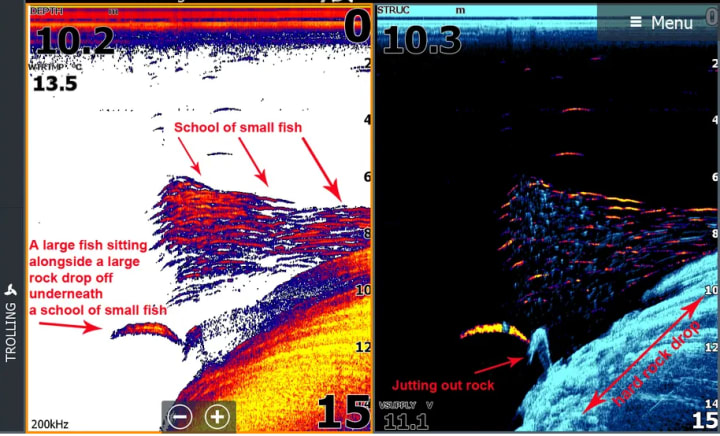How to Read Fish Finder
How to Read Fish Finder

I am going to allow you in on a little secret here ... we made a decision to compose this beginners' guide to reviewing a fish finder since every other short article we located on this topic was poor.
They were either as well technological, also basic or they only covered one particular element. YouTube material had not been much better either (although there is an excellent low-cost video program that we've assessed below ).
So we set out to create a succinct however thorough newbies' overview on how to review a fish finder screen.
A Beginner’s Guide to Reading Your how to read a humminbird fish finder
To compilate this guide we got in touch with fisherman, wildlife filmmaker and Lowrance pro Romen Dicovski to get him to explain the basics of using a fish finder with the help of five images he took off his Lowrance sonar unit while fishing recently. Romen has deliberately chosen these images to help us illustrate how easy it is to use a fish finder, and how you can tell what’s a fish vs structure, weed or other underwater objects.


Identifying Fish
The first thing you require to learn is just how to identify fish. For fishfinders with Fish-ID technology, recognizing fish can be a wind. This innovation transforms the raw information received from the water right into an user-friendly user interface to assist you translate what is listed below you.
Fish Icons

The Fish-ID innovation kind of fishfinder will certainly assist you locate small fish icons. You will get to see them in different dimensions and also sizes. The best component is that you can likewise watch different icons for plants, rocks, and schools of fish.
What is called for of you is simply to review the Symbol displayed on your screen and recognize the depth of the presented symbol?
Nonetheless, you need to be a little cautious with this; most Fish-IDs do feature their very own drawbacks. Most times, what your Fish ID will certainly display as a school of fish might become a team of plants after you have cast in your web. But with constant technique, you will get the hang of how to utilize them successfully.
Fish Arches

If you have an arch fishfinder, then anticipate to be receiving lines and arcs from the transducer. This sort of fishfinder will certainly conserve you a lot of time once you comprehend how they work.
They represent fish as arcs much more plainly than Fish IDs. So when your fishfinder reveals larger arcs, it suggests it has actually found a big fish, while small arc will certainly convert to smaller sized fish.
Though it might be a trouble attempting to determine rocks and also plants from arches, with time, you'll get the hang of exactly how to make use of and also understanding your fishfinder photos to identify structures and also classify fish based on their place and dimension.
Depth, Temperature, and Speed Sensors

To review a fish finder, it is essential to understand exactly how one works. Sonar waves are released from the transducer, or bottom part of the fish finder that is positioned in the water. They jump about as well as return to the transducer, and the transducer reads the rate, distance, and also price at which these waves return. The transducer after that transforms this raw data into visual information, typically thick, displayed lines and also arches. These lines are set at various depths, and also you can inform where a fish is based upon the deepness of where it shows up on the fish finder.
exactly how to review fish finder screen. The first thing you need to be able to understand is a generally located attribute existing in the majority of modern day fish finder versions. This feature is the depth finder. Numerous fish finders have a deepness sensing unit on the transducer, and this implies that you will have the ability to tell exactly how deep the water listed below your vessel is. The depth of the water can inform you the types of fish in the environment, what to anticipate listed below you and also it can just be valuable as a whole. Usually, on the top left of the fish finder's screen, the deepness will normally be shown. Often in meters as opposed to feet, the deepness should be clear and also relatively exact, with the precision relying on the specific fish finder design that you acquisition.
Typically, you can see the water temperature straight listed below the deepness analysis. This is likewise valuable for finding particular species of fish, as some like cozy water and also others thrive in cooler atmospheres. Making use of just those two features, you can currently begin looking for fish and observing the different settings some kinds of fish favor.
An additional beneficial point found on the majority of fish finder screens is the rate sensor. The rate sensor displays just how fast you are moving, sort of like a speedometer right there on your fish finder. Obtaining familiar with these things is what makes a better angler and a more skilled angler. It is necessary to be able to utilize and appreciate the extra features that fish finders give, besides just the sonar analyses of the ocean. Recognizing all the little points is so crucial, so make sure to pay attention to information when you first acquire a fish finder.
Sonar screen (Searchlight Sonar)

Fish school echo; if you hover the cursor over the displayed echoes, it shows the distance from your ship to the fish school, as well as the target's depth and where it is located in relation to your vessel.
- Own ship position (Triangle)
- Ship's track (By connecting a GPS)
- Sea bed echo (It forms a ring as the sensor is rotating)
- Sea current echo (Located insided the circle, it generally looks like irregular echoes)
- Beam inclination (tilt)
- Range
Conclusion
Romen utilized to fish extra generally casting sidewards right into likely framework without counting so much on the fish finder. But that's changed entirely in recent years and his catch price has actually substantially enhanced.
" I wouldn't go out on the water without one now, "he claims." I rely upon it 99% of the moment I am angling. I catch more fish vertically fishing depending on the fish finder than I ever caught spreading laterally into the wild.
" I currently invest at least 80% of the time checking out my finder and also occasionally 100% of the time. When you learn how to check out the fish finder you soon learn which fish are active and which fish aren't.".
Clearly there is far more to obtaining the most out of your fish finder than we can cover below, but the purpose of this overview was simply to given those starting a fast as well as simple overview to interpreting the photos a fish finder produces so they can begin seeing the arcs (and then capturing) a lot more fish or to help them determine whether to mount a fish finder on their boat and also kayak.
Stay tuned for much more follow-up fish finder ideas from us here.






Comments
There are no comments for this story
Be the first to respond and start the conversation.